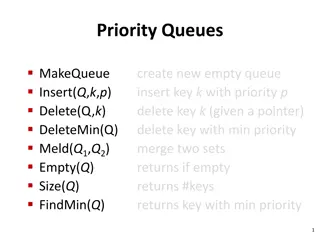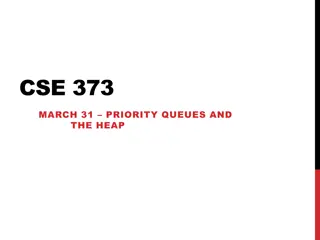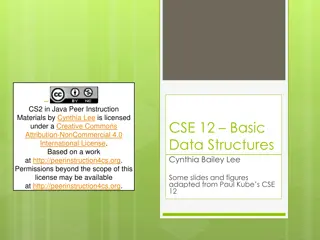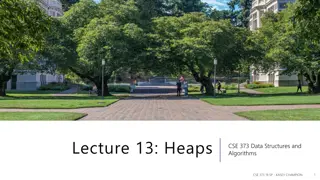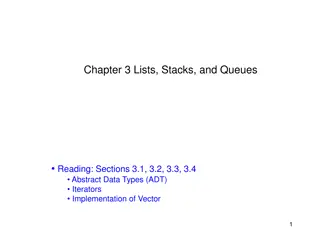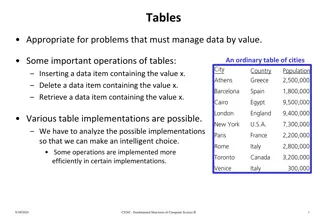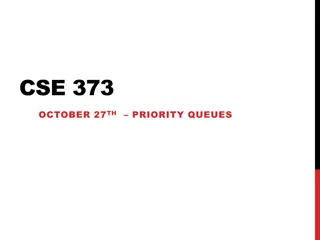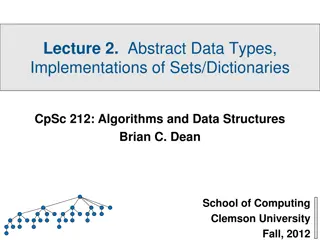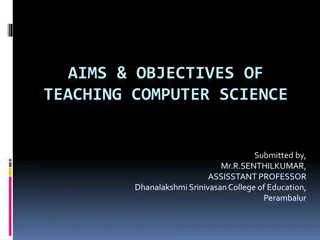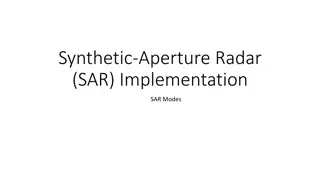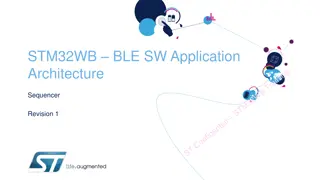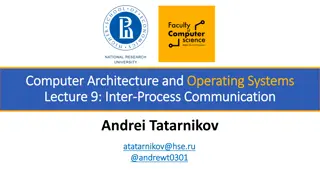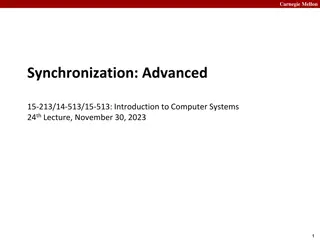Understanding Queues in Computer Science: Principles and Implementations
Explore the concept of queues in computer science, focusing on ordered collections of data following the FIFO principle. Learn about queue ADTs, implementations in Python, and delve into a simulation of a Printer Queue problem. Discover how to model printing tasks as random events and analyze the impact of different settings on printer performance through simulations.
Download Presentation

Please find below an Image/Link to download the presentation.
The content on the website is provided AS IS for your information and personal use only. It may not be sold, licensed, or shared on other websites without obtaining consent from the author. Download presentation by click this link. If you encounter any issues during the download, it is possible that the publisher has removed the file from their server.
E N D
Presentation Transcript
COMPSCI 107 Computer Science Fundamentals Lecture 13 Queues
ADT - Queue Ordered collection of data Items are added to the back of the queue Items are removed from the front of the queue Remove data in the same order as the data added First in, first out (FIFO) Operations Enqueue Dequeue Peek Is_empty Size COMPSCI 107 - Computer Science Fundamentals 2
Queue Implementation Implementation using Python list class QueueV1: def __init__(self): self.items = [] What is the big-O of enqueue()? def is_empty(self): return self.items == [] What is the big-O of dequeue()? def enqueue(self, item): self.items.insert(0,item) def dequeue(self): return self.items.pop() def size(self): return len(self.items) COMPSCI 107 - Computer Science Fundamentals 3
Example: Printer Queue Simulation Problem: Can the current printer handle the task load if it were set to print with a better quality but slower page rate? Write a simulation which models the printing tasks as random events of various lengths and arrival times. The current setting on the printer is 10 pages per minute and gives lower quality printing. The output will tell us if the wait times are significantly different if we use the better quality setting on the printer (5 pages per minute). On average, a job is sent to the printer every 3 minutes. Each job is between 1 and 20 pages. COMPSCI 107 - Computer Science Fundamentals 4
Printer Queue Simulation Run ten simulations each for 3600 (simulated) seconds. Each second there is 1 in 180 chance that a new print job of 1 to 20 pages is sent to the printer. simulation(10) 1. Average Wait: 16.90 secs. 0 tasks queued 2. Average Wait: 2.72 secs. 0 tasks queued 3. Average Wait: 26.75 secs. 1 tasks queued 4. Average Wait: 3.45 secs. 0 tasks queued 5. Average Wait: 5.60 secs. 0 tasks queued 6. Average Wait: 22.56 secs. 0 tasks queued 7. Average Wait: 14.71 secs. 0 tasks queued 8. Average Wait: 25.79 secs. 0 tasks queued 9. Average Wait: 4.28 secs. 0 tasks queued 10. Average Wait: 5.79 secs. 0 tasks queued COMPSCI 107 - Computer Science Fundamentals 5
Printer Queue Simulation Run 10 simulations of an hour of printing simulate_hour function returns a tuple consisting of: list containing the number of seconds that each print job waited in the queue, and an integer representing the number of jobs remaining in the queue def simulation(ppm): for n in range(1, 11): wait_times, jobs_queued = simulate_hour(ppm) average_wait = sum(wait_times) / len(wait_times) print('{:2}. Average Wait: {:6.2f} secs. {} tasks queued'.format( n, average_wait, jobs_queued)) COMPSCI 107 - Computer Science Fundamentals 6
Printer Queue Simulation import random def simulate_hour(pages_per_minute): spooler = queue() pages_to_print = 0 wait_times = [] for current_time in range(3600): if random.randint(1, 180) == 1: pages = random.randint(1, 20) spooler.enqueue((pages, current_time)) if pages_to_print <= 0 and not spooler.is_empty(): #start printing a new job pages_to_print, start_time = spooler.dequeue() wait_times += [current_time - start_time] pages_to_print -= pages_per_minute / 60 #add a new job to the print queue #pages printed each second return (wait_times, spooler.size()) COMPSCI 107 - Computer Science Fundamentals 7
Exercise One possible implementation of the ADT Queue is given here. class QueueV1: def __init__(self): self.items = [] Is it possible to make a more efficient implementation? def is_empty(self): return self.items == [] Discuss in groups how you might improve the implementation of the Queue ADT in Python. def enqueue(self, item): self.items.insert(0,item) def dequeue(self): return self.items.pop() def size(self): return len(self.items) COMPSCI 107 - Computer Science Fundamentals 8
Circular Queue A Python list is used to store the data Create an initially empty list of a given size Treat the list as if it were circular Keep index of the front of the queue Keep index of the back of the queue Enqueue and Dequeue Items are enqueued at the back Items are dequeued at the front COMPSCI 107 - Computer Science Fundamentals 9
Exercise Write the implementation for the Circular Queue. A circular queue is created by passing the constructor an initial capacity q = circular_queue( 1000 ) class circular_queue: def __init__(self, capacity): #creates empty list, count, front, back def is_empty(self): def enqueue(self, item): def dequeue(self): def size(): COMPSCI 107 - Computer Science Fundamentals 10
Exercise What is the big-O running time for each of the circular_queue methods? class circular_queue: def __init__(self, capacity): #creates empty list, count, front, back def is_empty(self): def enqueue(self, item): def dequeue(self): def size(): COMPSCI 107 - Computer Science Fundamentals 11
Exercise How does a user know if the circular_queue is full? What should happen when the circular_queue is full? Discuss class circular_queue: def __init__(self, capacity): #creates empty list, count, front, back def is_empty(self): def enqueue(self, item): def dequeue(self): def size(): COMPSCI 107 - Computer Science Fundamentals 12
ADT Deque A Double-Ended Queue or Deque (pronounced Deck ) An ordered collection of items where items are added and removed from either end, either front or back add_front() add_rear() remove_front() remove_rear() is_empty() size() COMPSCI 107 - Computer Science Fundamentals 13
Exercise Use a double ended queue to write a function that determines if a string is a palindrome. A palindrome is a sentence in which the letters appear in the same order forwards and reverse. Punctuation is ignored. >>> is_palindrome( bob ) True COMPSCI 107 - Computer Science Fundamentals 14
Bob Weird Al Yankovic Ah, Satan sees Natasha No devil lived on Lonely Tylenol Not a banana baton No "x" in "Nixon" O, stone, be not so O Geronimo, no minor ego "Naomi," I moan "A Toyota's a Toyota" A dog, a panic in a pagoda I, man, am regal - a German am I Never odd or even If I had a hi-fi Madam, I'm Adam Too hot to hoot No lemons, no melon Too bad I hid a boot Lisa Bonet ate no basil Warsaw was raw Was it a car or a cat I saw? Oh no! Don Ho! Nurse, I spy gypsies - run! Senile felines Now I see bees I won UFO tofu We panic in a pew Oozy rat in a sanitary zoo God! A red nugget! A fat egg under a dog! Go hang a salami, I'm a lasagna hog Rise to vote, sir Do geese see god? "Do nine men interpret?" "Nine men," I nod Rats live on no evil star Won't lovers revolt now? Race fast, safe car Pa's a sap Ma is as selfless as I am May a moody baby doom a yam? COMPSCI 107 - Computer Science Fundamentals 15


